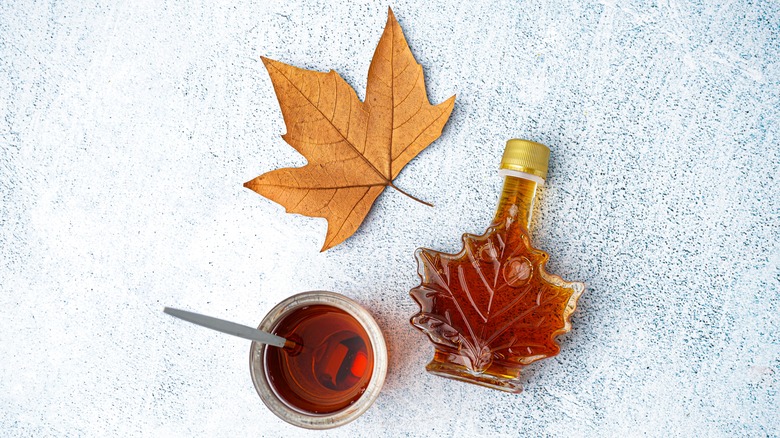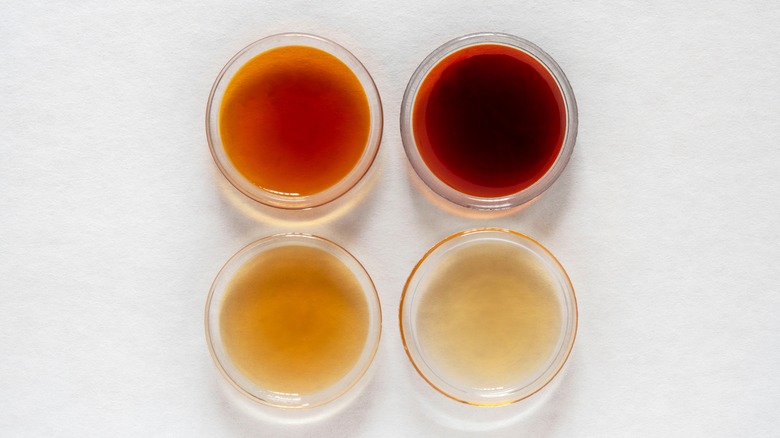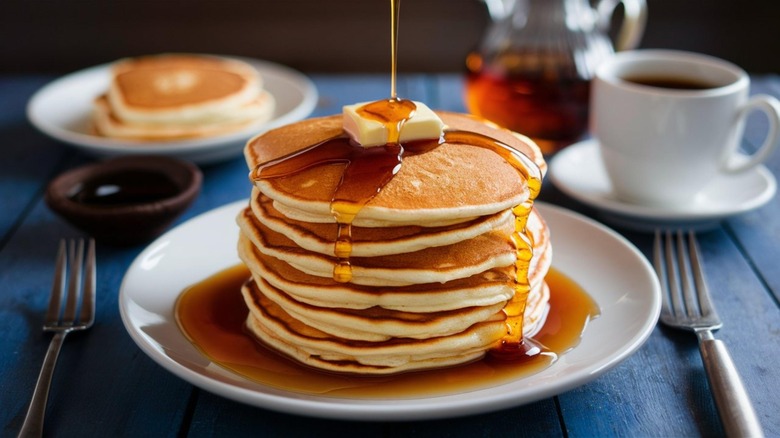What Makes Grade A And Grade B Maple Syrup Different?
The label "Grade B" maple syrup is both inaccurate and misleading. Not too long ago, the classifications of maple syrup were an absolute mess — with each U.S. state given free reign to create and order their own classification systems.
Grade B once referred to top-quality maple syrup that was substantially darker and thicker than Grade A syrup. However, consumers interpreted this label to mean that Grade B syrup was somehow inferior to Grade A. It didn't help that the other classifications, light, medium, and dark, were all considered "Grade A" as well.
However understandable this misinterpretation may have been, Grade B syrup met the same quality standards as the three Grade A syrups. In fact, the only thing setting Grade B apart was its stronger taste and darker color. Its demand simply suffered thanks to poor marketing under the Grade B label.
In 2011, The International Maple Syrup Institute (IMSI) petitioned the USDA to codify a nationwide set of standards. Since Grade B syrup was in no way inferior to Grade A, the USDA changed its classification to Grade A Very Dark. Since 2015, the modern maple syrup classification system divides Grade A syrup into four groups: Grade A Golden, Amber, Dark, and Very Dark (formerly known as Grade B).
What makes a syrup Grade A?
Grade A syrups are quality tested with six distinct categories. To be Grade A, the syrup must succeed in all categories or be labeled Grade B for Reprocessing, meaning it can't be sold directly to consumers and can only be used for the manufacturing of other foods like candy or maple-flavored whiskey.
First, syrup must have no more than 68.9% solids measured in Brix. Brix is a unit measuring the percentage by weight of sugar in a solution. "Solids" mostly refers to the sugar content of syrup but also includes other solids carried over from tree sap. So, in basic terms, this means that Grade A syrup must be less than 68.9% sugar.
Second, a Grade A syrup requires uniformity in color, meaning that there are no fluctuations of shading or coloring in a tested amount of syrup. It must also be crystal clear without any cloudiness, haziness, or sediment.
Finally, it needs high-quality flavor and odor in line with its color. Officials measure the percentage of light that transfers through the syrup to exactly determine the syrup's classification. So even if an exceptionally dark syrup tastes and smells like Grade A Golden and passes all other quality tests, it is not Grade A syrup.
Provided a syrup passes these tests, it's then divided into the four previously mentioned categories from most delicate taste (Amber) to strongest taste (Very Dark).
How to use different Grade A syrups
Grade A golden syrup is ideal for recipes calling for just a touch of maple syrup taste. Whether you're adding a dash of sweetness to a vinaigrette dressing or learning how to poach eggs in maple syrup, the light, flowery taste of golden syrup is ideal.
Amber syrup makes for a great golden syrup substitute, provided you want a bit more maple flavor. Of the syrup classifications, it's possibly the most versatile as it balances flavor and viscosity while providing a sweet flavor of caramel and vanilla. It pairs well with bacon whether it's for espresso maple bacon or maple bacon bourbon pops.
Dark syrup is thick with a robust taste perfect for drizzling over pancakes and waffles. It has the ideal balance of not being too thick to consume directly but enough flavor for more robust recipes. Use dark syrup for dishes that put maple flavoring front and center like this maple-bourbon sweet potato pie.
Very dark syrup is the thickest and most flavorful of all the Grade A syrups and has recovered well from its previous Grade B classification. It's ideal for recipes that need plenty of maple flavor but become compromised by too much sweetness. Add it to recipes that already include plenty of sugar, like a classic Thanksgiving pumpkin pie, to impart plenty of maple flavor without making it overwhelming.



